Contact me Go to home page Return to main travel page
Cuba
2012
*
Michael Kluckner
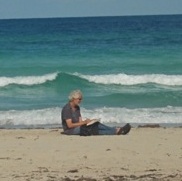 This
was a challenging trip, in some ways reminiscent of India
due to the noise, air pollution, crowded streets and crumbling
buildings, but definitely worthwhile in order to see Cuba as
they've made it themselves, with most of their revolutionary
legends still intact. This snapshot Christine took of me on
Varadero Beach, the day before we returned to Canada, didn't
represent the typical conditions! We were travelling
independently, using the Viazul bus system, and spent all but the
last two days in Cuban towns and cities. From my point of view of
drawing/painting en route, the best locales were bars, where the
comfort of a mojito or a Cuba Limón helped the flow of the wrist
and the bar itself kept away the jineteros (the hustlers
and touts). One truism: my vacation pencil is too lazy to draw the
complexities of colonial architecture. Drawing buildings is work,
drawing people is pleasure. This
was a challenging trip, in some ways reminiscent of India
due to the noise, air pollution, crowded streets and crumbling
buildings, but definitely worthwhile in order to see Cuba as
they've made it themselves, with most of their revolutionary
legends still intact. This snapshot Christine took of me on
Varadero Beach, the day before we returned to Canada, didn't
represent the typical conditions! We were travelling
independently, using the Viazul bus system, and spent all but the
last two days in Cuban towns and cities. From my point of view of
drawing/painting en route, the best locales were bars, where the
comfort of a mojito or a Cuba Limón helped the flow of the wrist
and the bar itself kept away the jineteros (the hustlers
and touts). One truism: my vacation pencil is too lazy to draw the
complexities of colonial architecture. Drawing buildings is work,
drawing people is pleasure.A few notes about travelling in Cuba for anyone contemplating a visit ... read more Because of those revolutionary legends and all the art they've spawned, especially about Ché Guavara, I've divided this very lengthy article into 3 sections: • the artwork I managed to do, mainly in pencil in a small Moleskine sketchbook (as it just wasn't a watercolour sort of a place), which begins below • Jump to images of Ché • Jump to street art we came across, mainly humorous and anti-imperialist. Our route, last half of October, 2012: we didn't get as far as we might have due to Hurricane Sandy and our aversion to heroic bus trips (15 hours from Havana to Santiago, for example) Woman observing the passing parade of "Yank Tanks" and trucks on the Calle San Lazaro, Havana Centro: the view out the window of the "Casa 1940" casa particular. |
| Above: this is barely readable, so... the front of
the building across from us, on the Calle San Lazaro in Havana
Centro, had collapsed into the street, leaving a sort of terrace
where the second floor had once been. Nevertheless, it was still
occupied. The view past it took in a piece of the famous
waterfront boulevard called the Malecon and a lovely rectangle
of blue ocean. Two old ladies often stood on the balcony of the
building next door to observe the passing parade. At the bottom,
I wrote: "The same decrepitude – crumbling masonry inhabited –
that you see in India." Parts of Havana look like they've been
shelled by artillery. Below: a few snapshots from my phone camera of buildings in Havana Centro. As I mentioned above, colonial architecture is way too much work to draw on holiday... |
| ... and no one would have believed this balcony if I had
drawn it. |
| There's an observation terrace atop the Bacardi Building,
a dozen-storey art-deco landmark on the edge of Habana Vieja,
the old city. The view across the crumbling city is astonishing,
looking down onto the filthy walls with their peeling paint, the
cluttered rooftops, deep shadows and mottled colours. The colour
patterns were so intricate it reminded me of a Turkish carpet
bazaar, becoming almost an abstract image in the blue haze. I
painted it in oils at home after the trip (this is a 40 x 40
inch canvas), mixing in the 'real' buildings I recorded in
snapshots with the cell-phone camera. |
A similar common sight on the streets is men underneath 1940s/50s cars with tools, trying to keep them running...
Waiting out a thunderstorm in Havana under one of the ubiquitous loggias
| The greatest pleasure anywhere in Cuba is sitting in a
bar with a good mojito, one where the bartender grinds fresh
mint leaves with a little sugar, and listening to a band playing
the kind of unamplified music made famous 15 years ago by Ry
Cooder and the Buena Vista Social Club album and film. A Cuba
Limón is second best; we weren't fans of the Cuba Libre, aka rum
'n' coke, which is made from local cola rather than Coca Cola
(banned from Cuba along with everything else American – imagine
going 2 weeks anywhere in the world without seeing a Coke
logo!). Lots of perspiration stains on the paper: temperature
about 32 with very high humidity.... |
| Left: Habana Vieja is the magnet for tourists and
has received the most international money (it is a UNESCO World
Heritage Site) to help with its restoration. The streetscapes
are a wonderful jumble of balconies, laundry, plants, vintage
cars and people. Below: Men in inner tubes fishing with hand lines in a shallow lake near Cienfuegos, truly something I had never seen before... |
| This one's for Richard aka Ricardo: the floor plan of a
typical Cuban colonial house. This is the casa in
Cienfuegos, a beautiful space with 20-foot-high ceilings. The standard plan is two rooms and a hallway coming in from the street: front doors open directly off the sidewalk, as in the watercolour above of the woman in the doorway. The hallway opens onto a courtyard with rooms running down one side – the guest bedrooms in a casa particular – with a dining room, kitchen and more family rooms at the back. The courtyards were used for sitting, growing plants, hanging laundry and, in Santa Clara, housing chickens. |
| The bar at the Teatro Terry in Cienfuegos, where (as I
scribbled on the page) we went for a drink partly to watch a
dance class that was using part of its outdoor terrace. When a
thunderstorm suddenly blew in, we were pleasantly trapped,
observing the young Cubanos who followed us into the indoor part
of the bar. This was just tropical rain, a typical summertime event, and broke the heat and humidity for a few hours. It was a few days later when Hurricane Sandy's arrival cooled everything down across the island and killed a dozen people in Santiago. |
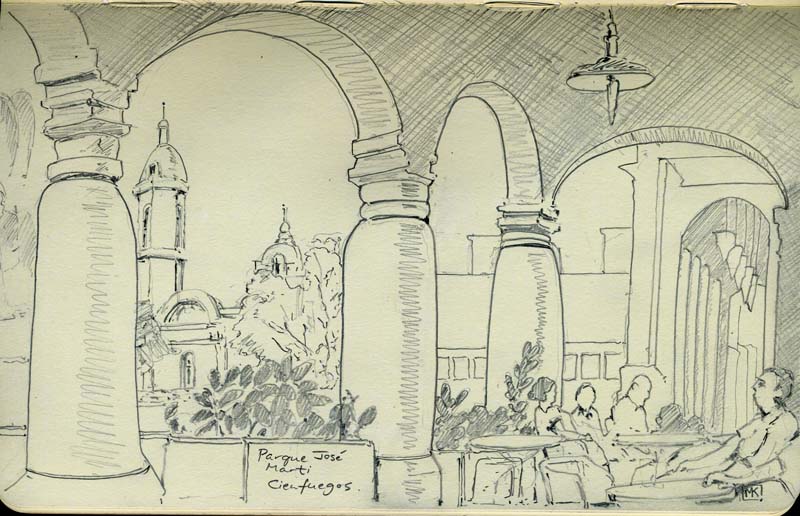
Another afternoon, another bar ... this one across the parque from the Teatro Terry. The entire square is a World Heritage Site.
| It was this Ché billboard ("your example lives – your
ideas will endure") on the Parque José Marti that started me
recording the Ché
images we saw. It seemed a bit presumptuous to put Ché
next to the Catholic church, whose ideas had endured for 2,000
years and whose popularity couldn't be stamped out in the 50
years since the Revolution. Elsewhere in Cienfuegos, the Young
Communist Club stood on the opposite end of the block from a
Baptist Church. Below: the best bar and band in Trinidad, in a courtyard on the Calle Villena near the Plaza Mayor. The box bass described on the right was the first one I'd ever seen; it played only five notes, enough to provide a solid base line for the music, which included the "Buena Vista"-type standards and, arghhh, Guantanamera. The 'Ry Cooder-type character' might have been European, or a past winner of a David Crosby lookalike contest, and played very well. |
October 25th: we just got the lashing tail of Hurricane Sandy – soaking rain for a day after an hour in the middle of the night of shrieking wind.
We took one tourist excursion from Trinidad, on the old steam train that chuffs out into the 'valley of the sugar mills.' It was an amusing day, watching the tourists (mainly Germans) with huge cameras filming everything, then getting raucous in the bar car on the way back. First stop was a village called Ignaza, where a masonry tower about 20 metres high survives from the sugar mill and slavery era and presumably offered the overseer or owner a good viewpoint for inspecting the work on the plantations, all of which have disappeared. For me, the tower was an opportunity to look down on a village of small houses, most of concrete block, placed almost randomly on a landscape of small plots with chickens and pigs and shaded by palms and big jungle-type trees. It didn't look much different from a Costa Rican or Mexican village except there were fewer consumer goods (certainly almost no cars or motorbikes) and less rubbish. Many of the hedges bordering the properties were a sort of cactus, Euphorbia laetea, that is a common house plant in Canada. The second stop on the excursion was a finca (farm) that had seen better days. There was nothing to do but drink and wait for the train to turn around and point back to Trinidad. I whiled away the time drawing the animals, including one of the starving dogs, in its horrid farmyard. Always, in Spanish-speaking countries, there is an undercurrent of cruelty, adding to the memories of slavery on the plantations. One café in Trinidad was decorated with iron shackles, including a tiny set for a child. |
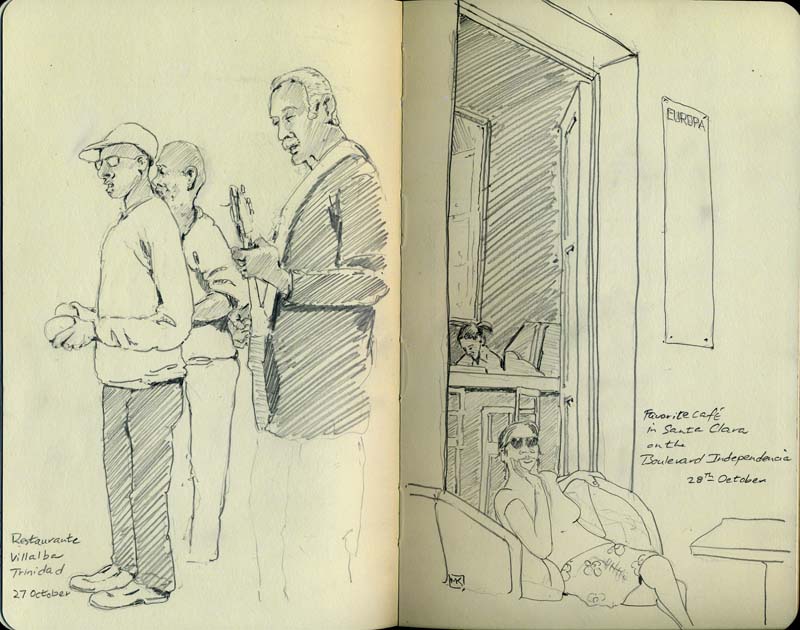
On to Santa Clara, the interior city where Ché led his brigade to victory in the final battle of the revolution (Raul Castro, Fidel's brother and the current president, led another).
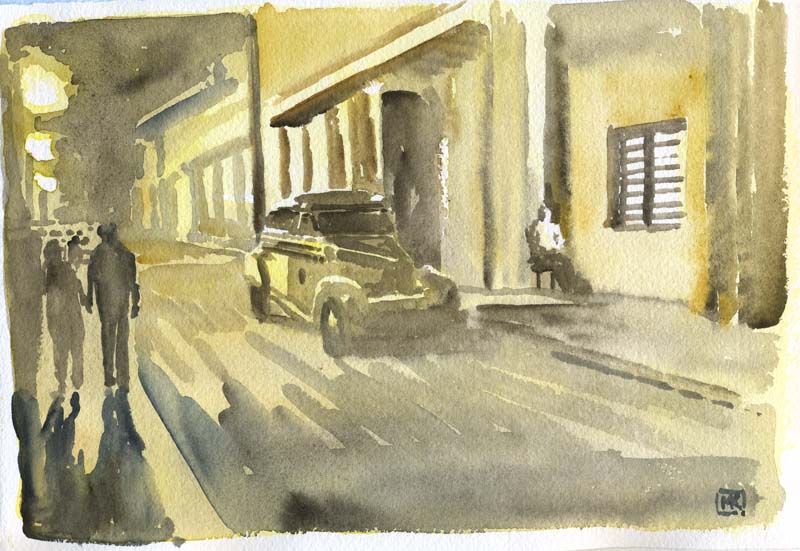
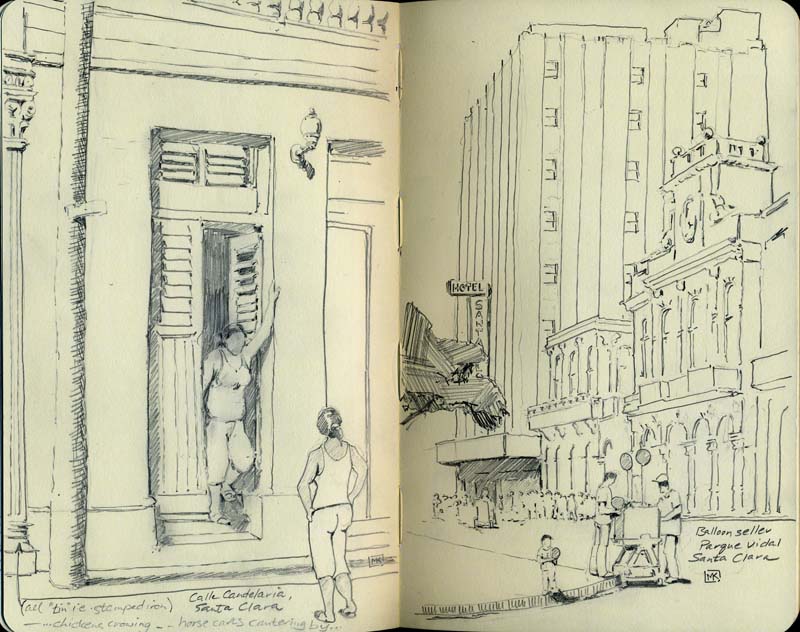
| The Parque Vidal, the central square in Santa Clara, was
the meeting place day and night for the populace. Ringed by
historic buildings, including the main theatre, library and
highschool, it was thronged with people. At night, a band played
in the bandstand. On the weekend, a number of the buildings
hosted peñas, a word that appeared to mean 'small free
concert', in their lobbies and courtyards. I drew the crowd of
people outside a dancing demonstration – at least that's what we
took it to mean, but it turned out to be just an opportunity for
Cubans to dance under the loggia and on the street in front of
the Casa de la Cultura. The Hotel Santa Clara (its sign appended
with the word 'Libre') is the only modern building on the
square, and still bears the bullet holes in its facade from
Ché's assault in 1959. Santa Clara is worth a journey for the fabulous Ché memorial: images on the Ché page. |
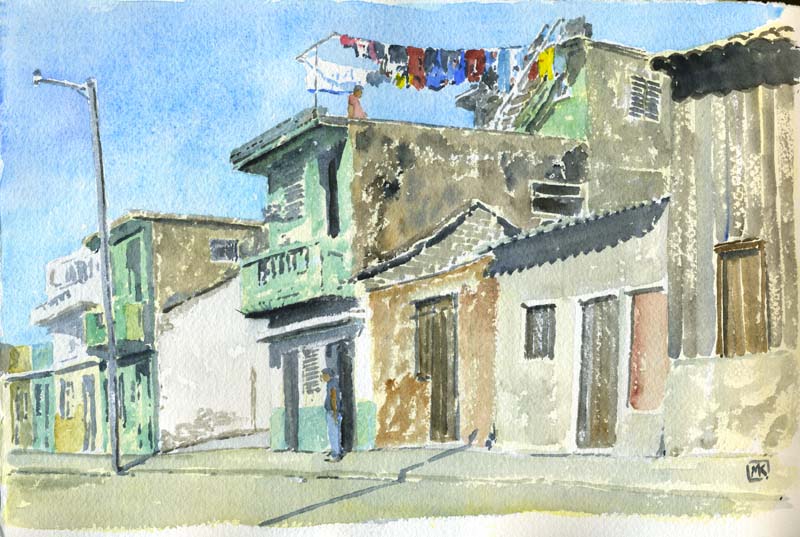
A modest Santa Clara street: incredible textures of old wood and paint, buildings abandoned, roofs fallen off, a few vacant lots, laundry drying, everybody going about their lives....
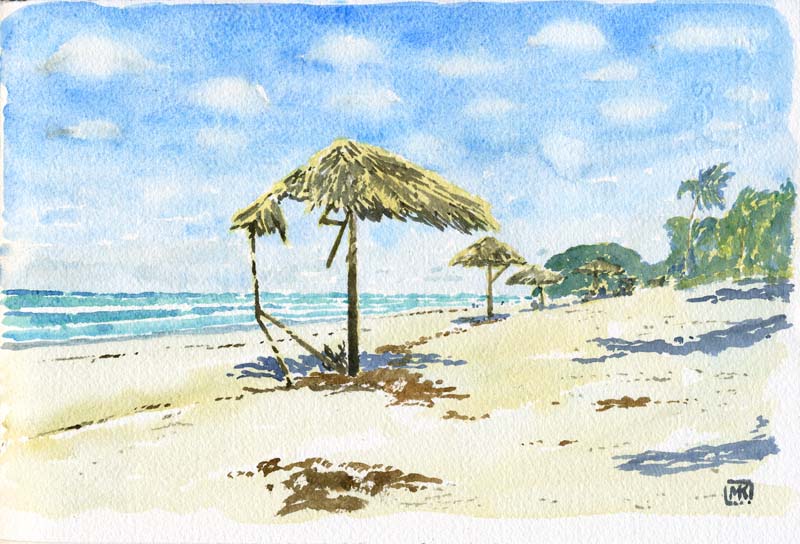
we took the bus from Santa Clara to Varadero to see what the resort experience looked like, and stayed in a crummy 1950 hotel on the main drag (it wasn't just cheapness – nearly all the hotels are rented 'all-inclusive,' which we didn't want). Varadero had a beautiful beach, still showing evidence of storm damage, but altogether it was a pretty dull place after the interesting Cuban towns. The economy is totally focused on extracting CUCs from tourists with bad art and crafts and overpriced food and booze .... but, we travel to be stimulated, not to de-stress, so I can't be too critical, maybe. |
Contact me Go to home page Return to main travel page
Artwork & text © Michael Kluckner, 2012